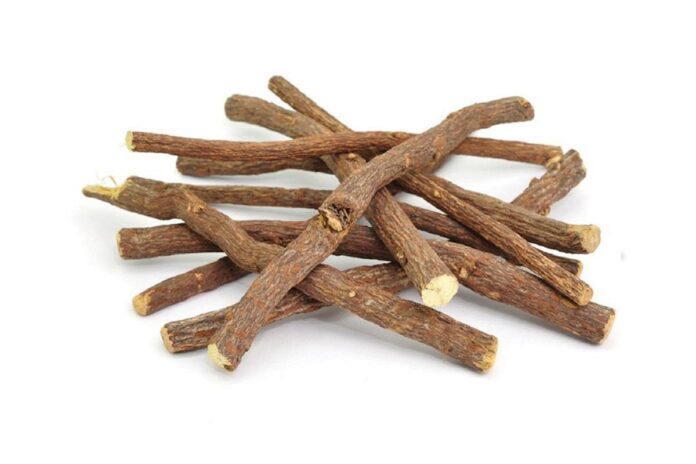Like garlic, licorice has been used since ancient times as a traditional herbal remedy—to treat colds, aid digestion, and for countless other reasons. Scientists have discovered, however, that licorice has its potentially good and bad sides.
We’re talking only about true licorice, which is an extract of the root of the Glycyrrhiza plant (usually Glycyrrhiza glabra) and contains hundreds of bioactive compounds. You probably know it only as candy, but it is also used as a sweetener and flavoring agent in many foods, tobacco (notably chewing tobacco), and other products. However, most licorice candy in the U.S. is not the real thing: Labeled “licorice-flavored,” it is flavored artificially or with various natural oils, such as anise, which has a sweet, aromatic flavor similar to licorice. Red licorice has nothing to do with real licorice or its flavor.
You’re more likely to find real licorice in imported European candy, which will list “licorice extract” or “licorice root powder” as an ingredient. Licorice extract is also sold as dietary supplements (capsules, tablets, or liquid), often combined with other herbs in formulas marketed, say, to relieve “stomach discomfort” or menopausal symptoms. The following discussion focuses on true licorice.
Potential benefits of licorice

Among licorice’s potentially beneficial compounds are many flavonoids and triterpenoids. A Chinese article published in Planta Medica in 2015 indicated that several of these had anti-inflammatory, antioxidant, antibacterial, and immune-modulating activities. Another Chinese review article, published in the Journal of Agricultural and Food Chemistry in 2014, describes how compounds in licorice may have anti-cancer effects by inhibiting blood vessel formation and inducing cancer-cell suicide. Keep in mind that it’s a long way from such lab research to clinical evidence of efficacy for the treatment of human disorders.
Complicating matters are problems facing all herbal therapies: Different species of Glycyrrhiza may vary in their chemical composition and concentration, as will foods and supplements containing them. In particular, it’s hard to predict what impact licorice might have on the risk of cancer (or conditions such as menopausal hot flashes), since some of its flavonoid compounds have estrogenic effects, while others have anti-estrogenic effects.
The Natural Medicines database, which evaluates herbal and other alternative therapies, concluded that there is “insufficient reliable evidence” to evaluate claims that licorice extract can help treat hepatitis, high cholesterol, menopausal symptoms, irritable bowel syndrome, peptic ulcers, canker sores, gingivitis, and a host of other conditions or diseases. One condition for which it did find enough evidence to rate licorice as “possibly effective” is dyspepsia (a vague condition usually called indigestion), but only as an ingredient in a German herbal formula called Iberogast.
Potential risks of licorice
Licorice contains glycyrrhizin, a compound that in susceptible people can interfere with the action of some hormones that affect the body’s sodium and water balance. For them, regularly consuming even moderate amounts can lead to retention of sodium and water, reduced potassium level, and other imbalances in body chemistry, potentially leading to dangerously elevated blood pressure. Typically, this becomes significant only when people eat two ounces or more of licorice candy daily for weeks or months, but problems have also been reported with smaller portions over shorter periods in people with cardiovascular or kidney disorders.
What’s more, licorice can interact with certain medications because it can inhibit enzymes involved in their metabolism. For example, people taking anti-clotting medication (such as warfarin) or digoxin (a heart drug) should talk with their doctor or pharmacist before consuming real licorice, especially large amounts. The Natural Medicines database also lists possible interactions with blood pressure medications, corticosteroids, diuretics, and a wide range of other drugs.
Another issue: A 2017 study from Finland, where licorice candy is popular (and Panda licorice is proudly produced), found that children whose mothers had consumed large amounts (more than a pound a week) during pregnancy performed worse on cognitive tests and were more likely to have attention deficit hyperactivity disorders than children whose mothers had consumed little to no licorice. Animal research suggests that a high maternal intake of glycyrrhizin can have a negative effect on fetal development. For these and other reasons, the Natural Medicines database rated licorice, especially at high intakes, as “unsafe” during pregnancy.
Bottom line: As candy, licorice is high in sugar and calories, so eat only small portions. You should especially limit your intake of real licorice, unless the package says “deglycyrrhizinated” or “deglycerized,” meaning that the glycyrrhizin has been removed. Your best strategy is to stay away from genuine licorice if you have high blood pressure or heart disease, are using diuretics or the blood thinner warfarin, are pregnant or nursing. If you take medication, ask your doctor or pharmacist if licorice may interact with it. Don’t take licorice as a dietary supplement to treat any medical condition or to improve your overall health. There’s no good evidence to support such claims.




